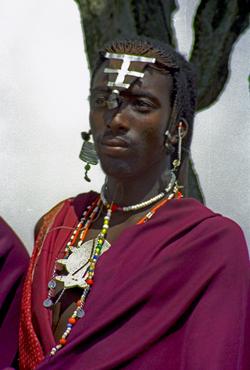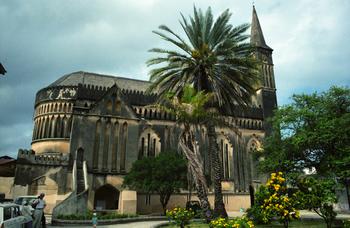East Africa

I travelled in East Africa for two months in 1994 with a wonderful company called Guerba. It was a camping trip that started in Kenya, and then travelled through Tanzania, Malawi, Zambia, Zimbabwe, and Botswana. Though it was long ago, those memories are still very vivid. At the time of my return it took at least a year for me to stop having out-of-body experiences where I was back in Africa, not sitting in traffic in the Vancouver rain.

We drove the back road to Karatu, which is the jumping off spot for Ngorogoro Crater. From what I’d seen so far, so much of Africa was contradictory. Violence and theft and smiling children. The shops that advertised themselves as ‘Butcher shop and Hotel’, or better yet ‘Beauty Shop and Butchery’.
Up the escarpment to the crater there were the superb starlings with their brilliant blue plumage. A spectacular view of the preserve displayed herds of distant animals spread across a low plain and salt pan. In that pristine scene we watched a hyena take down a young gazelle.

At dinner the wind swirled the charcoal-fire smoke around us as I peeled a billion potatoes for dinner. Next door, in a more plush camp, two black men shone the silver. We camped under a sausage tree that grew huge pods like deli-meat sausages before slicing. At lunch we ate under a lime tree with many of them littering the ground around us filling the air with their bright, sweet-acrid scent in the too-clear sunlight.
I was fascinated by the trees. Tulip trees bloomed bright orange-red and spread thick shade. Baobab squatted thick and leathery like something out of a Tolkien book, but apparently the Mau Mau used them as hiding places for their attacks on the colonists. Bougainvillea seemed to have been planted everywhere the European colonists lived. And then there were the Acacia trees that seemed flattened on the top by the immense weight of the sky.
I’d never seen sky like this. Once we left Ngorogoro crater the immensity of the Serengeti Plain seemed to go on forever. In the south the clouds hung low and showed signs of rain with the distant flow of sunlight through water. It placed a waterfall of light across the horizon and in the distance, robed figures swept across stubble fields, towards the downpour. A cool breeze ran across the red soil, eddying small dust devils.

At a dry camp in the Serengeti we had our first run-in with the insects the short rains bring. On the first night a cloud of flying termites were drawn to our lights. On the second night it was beetles. Small ones covered our packs and belongings. Large scarab beetles buzzed through the air and massed on the ground. They kept flying into my hair, crawling on my back. I finally couldn’t stand it anymore and went into my tent only to find that they followed me in, crawling in between the zippers. This stopped after I turned off the light and lay there breathless and totally creeped out. In the morning I realized I hadn’t slept alone when I found the bodies I’d crushed in my sleeping bag. Ugg.
But daylight brought the gifts we’d paid for in advance. We watched a mother cheetah teaching her four cubs to hunt. They killed a small Thompson gazelle, and though it was terrible to hear the gazelle scream as it fell, it was also a wonderful display of these cats’ prowess. We saw lion and leopard and hippo and giraffe, but I was still struck by the contradictions: Fine feathered black and white Marabou Storks were carrion eaters. The stately African eagle (with his white head so like the bald eagle) was a scavenger, and the aloof Maasai warrior sold his image at the side of the road.
In this part of Africa, nothing was as it seemed.
January 1994
The Dancing Train to Zanzibar-

I decided not to climb Mount Kilimanjaro, and instead opted to take the Moshi-Dar Es Salaam train across half of Tanzania and then the hydrofoil to Zanzibar. The railway station was everything anyone could want it to be: filled with people in bright colors, hawkers and small children and everyone seemed to be selling something—fruit juices, deep fried patties of something and fried fish set out on platters like silver links of a necklace. It was hot and immensely humid and the short rains came, opening the sky and deluging the area with heavy drops that cooled the body and soaked the clothing. I stood in the train car, putting my face and arms out the window to get wet and smell the cool, sweet air. Red dust ran in rivulets off my skin.
Our train compartment had two beds/bunks and a small sink and a window to the outside and into the hall. The ‘bathrom’ was down the hall. The train appeared to be a big event in town as everyone waved and shouted as the train pulled out for the coast.

The train stopped at every small town along the way and in between it moved in an up and down motion that made me think of Maasai dancers leaping. Dancing is an apt description. The railroad car leapt and bumped and crashed and crescendo’d through the night. Clouds rolled in and only allowed fingers of light to illuminate the landscape, but no rain falls.
As a result, the train was full of dust and so was I. It filled my nose, rimmed my eyes, and coated my skin and hair. As fast as I rinsed myself off, I was coated again because the dust filled the air. If it were to rain, surely all of us would have looked like the wounded returning from battle.

It was a sixteen hour train ride before we wound down through trees into the Indian Ocean coastal city of Dar Es Salaam. There we found our way to the harbor and the Sea Express and rode the hydrofoil to Zanzibar with a lovely young Indian woman who had her hands hennaed for her wedding.
Zanzibar. Just the name called to me of exotic. It rose out of the waves and sailed towards us under massive cumulous clouds, an island in azure surrounded by beaches and crowned with palms, with the graceful dhow boats wiht their tri-sails coasting around it. These are the same style of boats the Arabs used to trade up and down the coat before the Europeans rounded the Cape of Good Hope. We stayed at the Malindi hotel in old, stone, Zanzibar town where Stanley (or was it Livingston) was commemorated, and drank beer at the Zanzibar Hotel overlooking the water. Our hotel room was decorated with old, iron-studded Zanzibar trunks and African batik and Zanzibar prayer mats.
Walking the town showed us the old slave market, the huge, iron-studded Zanzibar doors, and helter-skelter narrow streets, lanes and alleys inhabited by thin cats, laughing children, black-swathed Muslim women, small dispensaries, cafes, and general stores. We ate tuna and curry for dinner and walked through the fish market on our way home where blue parrot fish lay side by side with silver scaled ocean denizens. The air reeked of old fish and distilled cloves, for this is one of the spice islands established when the blockade on the Indonesian Moluccas was broken. They grow pepper her and nutmeg and mace and cloves in the warm Indian Ocean air.
That old dancing train had danced me right back in time and deposited me there.

January 1994
The Okavango – Water and Sky

In one of the worlds’ largest deserts rests the Okavango delta—4,000 square miles of freshwater oasis—the largest in the world. When our aircraft crossed over the buffalo fence that was the boundary of the delta, we were still over dry country, but gradually riverbeds appeared with wide reed borders and glittering waterways shining in the sun against the hard edge of grass. There were many small copses of trees in small open areas that were presumably flooded during wetter times. We dove low and skimmed the top of the grass, scattering a small herd of zebra and giving me a concern that we’d catch a wingtip in the grass or on a termite mound. Then we rose up and cruised above scattered herds before bursting out over a sea of swamp and lilies and watched the sun reflect back at us from the shades of green and brown and maroon stained pools that stretched in all directions.
Inside, the Okavango was a place of quiet spaces tangled in the roots of the tall grass or along the nbarrow channels between the reeds and lily pads. We rode poled makoro (dug out canoes) along the water channels and all you could hear was the hiss of water on wood, air against the tall grass and chattering call of the African jacana as we disturbed it from its perch on a lily pad stalk. And then of course there was the chatter of the polers who had a distinctive soft ‘eh’ grunt that they used frequently when speaking.

When we stopped for lunch, one of the polers pulled out a traditional instrument called a sawarawara (sic?) that is made of wood and papyrus reed, with the white wood notched and strung with the reed and then another piece of wood run across it to form vibration that creates a haunting breathy sound. It made me think of deserts and reed and wind in the trees.
Back on the water, the waterways were full of thick mats of green reeds, and papyrus. There was hippo grass and other grass and the quiet and the sun, and in the distance on three horizons lightning and thunder walked arm and arm around us.
On Old Man Island we set up camp and went out on foot for wildlife viewing. We saw wildebeest, kudu, topi, zebra , impala and giraffe and a tortoise. As we walked, our guide pointed out various trees used in the making of the makoro. Apparently the Sausage tree, the Marula, the Sycamore, and the Jackleberry Trees are used. The best is the Sausage tree. They are chopped down with axes and then hollowed.
The Okavango was a good place. I will always think of the sound of Africa as the croon of the doves at first light and the sigh of the wind in tall grasses. Africa in the Okavango was a place of blue skies and lightning storms building , of fluffy white clouds and spikes of electricity nailing the sky to the ground. Africa needed these storms to hold the high ceiling of heaven to the wide, red earth below.
February 1994









